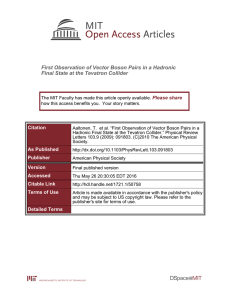Search for Pair Production of Supersymmetric Top Quarks
advertisement
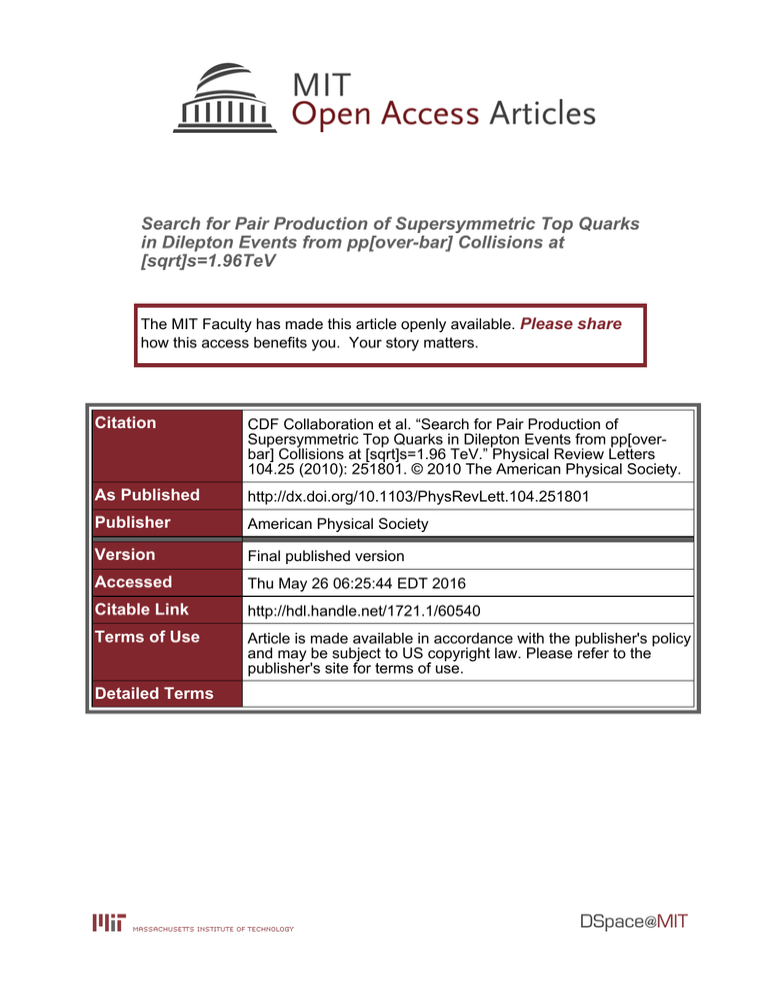
Search for Pair Production of Supersymmetric Top Quarks in Dilepton Events from pp[over-bar] Collisions at [sqrt]s=1.96TeV The MIT Faculty has made this article openly available. Please share how this access benefits you. Your story matters. Citation CDF Collaboration et al. “Search for Pair Production of Supersymmetric Top Quarks in Dilepton Events from pp[overbar] Collisions at [sqrt]s=1.96 TeV.” Physical Review Letters 104.25 (2010): 251801. © 2010 The American Physical Society. As Published http://dx.doi.org/10.1103/PhysRevLett.104.251801 Publisher American Physical Society Version Final published version Accessed Thu May 26 06:25:44 EDT 2016 Citable Link http://hdl.handle.net/1721.1/60540 Terms of Use Article is made available in accordance with the publisher's policy and may be subject to US copyright law. Please refer to the publisher's site for terms of use. Detailed Terms PRL 104, 251801 (2010) PHYSICAL REVIEW LETTERS week ending 25 JUNE 2010 Search for Pair Production of Supersymmetric pffiffiffi Top Quarks in Dilepton Events from pp Collisions at s ¼ 1:96 TeV T. Aaltonen,24 J. Adelman,14 T. Akimoto,56 B. Álvarez González,12,t S. Amerio,44b,44a D. Amidei,35 A. Anastassov,39 A. Annovi,20 J. Antos,15 G. Apollinari,18 A. Apresyan,49 T. Arisawa,58 A. Artikov,16 W. Ashmanskas,18 A. Attal,4 A. Aurisano,54 F. Azfar,43 W. Badgett,18 A. Barbaro-Galtieri,29 V. E. Barnes,49 B. A. Barnett,26 P. Barria,47c,47a V. Bartsch,31 G. Bauer,33 P.-H. Beauchemin,34 F. Bedeschi,47a D. Beecher,31 S. Behari,26 G. Bellettini,47c,47a J. Bellinger,60 D. Benjamin,17 A. Beretvas,18 J. Beringer,29 A. Bhatti,51 M. Binkley,18 D. Bisello,44b,44a I. Bizjak,31,y R. E. Blair,2 C. Blocker,7 B. Blumenfeld,26 A. Bocci,17 A. Bodek,50 V. Boisvert,50 G. Bolla,49 D. Bortoletto,49 J. Boudreau,48 A. Boveia,11 B. Brau,11,b A. Bridgeman,25 L. Brigliadori,6b,6a C. Bromberg,36 E. Brubaker,14 J. Budagov,16 H. S. Budd,50 S. Budd,25 S. Burke,18 K. Burkett,18 G. Busetto,44b,44a P. Bussey,22 A. Buzatu,34 K. L. Byrum,2 S. Cabrera,17,v C. Calancha,32 M. Campanelli,36 M. Campbell,35 F. Canelli,14,18 A. Canepa,46 B. Carls,25 D. Carlsmith,60 R. Carosi,47a S. Carrillo,19,o S. Carron,34 B. Casal,12 M. Casarsa,18 A. Castro,6b,6a P. Catastini,47c,47a D. Cauz,55b,55a V. Cavaliere,47c,47a M. Cavalli-Sforza,4 A. Cerri,29 L. Cerrito,31,p S. H. Chang,28 Y. C. Chen,1 M. Chertok,8 G. Chiarelli,47a G. Chlachidze,18 F. Chlebana,18 K. Cho,28 D. Chokheli,16 J. P. Chou,23 G. Choudalakis,33 S. H. Chuang,53 K. Chung,13 W. H. Chung,60 Y. S. Chung,50 T. Chwalek,27 C. I. Ciobanu,45 M. A. Ciocci,47c,47a A. Clark,21 D. Clark,7 G. Compostella,44a M. E. Convery,18 J. Conway,8 M. Cordelli,20 G. Cortiana,44b,44a C. A. Cox,8 D. J. Cox,8 F. Crescioli,47b,47a C. Cuenca Almenar,8,v J. Cuevas,12,t R. Culbertson,18 J. C. Cully,35 D. Dagenhart,18 M. Datta,18 T. Davies,22 P. de Barbaro,50 S. De Cecco,52a A. Deisher,29 G. De Lorenzo,4 M. Dell’Orso,47b,47a C. Deluca,4 L. Demortier,51 J. Deng,17 M. Deninno,6a P. F. Derwent,18 A. Di Canto,47b,47a G. P. di Giovanni,45 C. Dionisi,52b,52a B. Di Ruzza,55b,55a J. R. Dittmann,5 M. D’Onofrio,4 S. Donati,47b,47a P. Dong,9 J. Donini,44a T. Dorigo,44a S. Dube,53 J. Efron,40 A. Elagin,54 R. Erbacher,8 D. Errede,25 S. Errede,25 R. Eusebi,18 H. C. Fang,29 S. Farrington,43 W. T. Fedorko,14 R. G. Feild,61 M. Feindt,27 J. P. Fernandez,32 C. Ferrazza,47d,47a R. Field,19 G. Flanagan,49 R. Forrest,8 M. J. Frank,5 M. Franklin,23 J. C. Freeman,18 I. Furic,19 M. Gallinaro,52a J. Galyardt,13 F. Garberson,11 J. E. Garcia,21 A. F. Garfinkel,49 P. Garosi,47c,47a K. Genser,18 H. Gerberich,25 D. Gerdes,35 A. Gessler,27 S. Giagu,52b,52a V. Giakoumopoulou,3 P. Giannetti,47a K. Gibson,48 J. L. Gimmell,50 C. M. Ginsburg,18 N. Giokaris,3 M. Giordani,55b,55a P. Giromini,20 M. Giunta,47a G. Giurgiu,26 V. Glagolev,16 D. Glenzinski,18 M. Gold,38 N. Goldschmidt,19 A. Golossanov,18 G. Gomez,12 G. Gomez-Ceballos,33 M. Goncharov,33 O. González,32 I. Gorelov,38 A. T. Goshaw,17 K. Goulianos,51 A. Gresele,44b,44a S. Grinstein,23 C. Grosso-Pilcher,14 R. C. Group,18 U. Grundler,25 J. Guimaraes da Costa,23 Z. Gunay-Unalan,36 C. Haber,29 K. Hahn,33 S. R. Hahn,18 E. Halkiadakis,53 B.-Y. Han,50 J. Y. Han,50 F. Happacher,20 K. Hara,56 D. Hare,53 M. Hare,57 S. Harper,43 R. F. Harr,59 R. M. Harris,18 M. Hartz,48 K. Hatakeyama,51 C. Hays,43 M. Heck,27 A. Heijboer,46 J. Heinrich,46 C. Henderson,33 M. Herndon,60 J. Heuser,27 S. Hewamanage,5 D. Hidas,17 C. S. Hill,11,d D. Hirschbuehl,27 A. Hocker,18 S. Hou,1 M. Houlden,30 S.-C. Hsu,29 B. T. Huffman,43 R. E. Hughes,40 U. Husemann,61 M. Hussein,36 J. Huston,36 J. Incandela,11 G. Introzzi,47a M. Iori,52b,52a A. Ivanov,8 E. James,18 D. Jang,13 B. Jayatilaka,17 E. J. Jeon,28 M. K. Jha,6a S. Jindariani,18 W. Johnson,8 M. Jones,49 K. K. Joo,28 S. Y. Jun,13 J. E. Jung,28 T. R. Junk,18 T. Kamon,54 D. Kar,19 P. E. Karchin,59 Y. Kato,42,m R. Kephart,18 W. Ketchum,14 J. Keung,46 V. Khotilovich,54 B. Kilminster,18 D. H. Kim,28 H. S. Kim,28 H. W. Kim,28 J. E. Kim,28 M. J. Kim,20 S. B. Kim,28 S. H. Kim,56 Y. K. Kim,14 N. Kimura,56 L. Kirsch,7 S. Klimenko,19 B. Knuteson,33 B. R. Ko,17 K. Kondo,58 D. J. Kong,28 J. Konigsberg,19 A. Korytov,19 A. V. Kotwal,17 M. Kreps,27 J. Kroll,46 D. Krop,14 N. Krumnack,5 M. Kruse,17 V. Krutelyov,11 T. Kubo,56 T. Kuhr,27 N. P. Kulkarni,59 M. Kurata,56 S. Kwang,14 A. T. Laasanen,49 S. Lami,47a S. Lammel,18 M. Lancaster,31 R. L. Lander,8 K. Lannon,40,s A. Lath,53 G. Latino,47c,47a I. Lazzizzera,44b,44a T. LeCompte,2 E. Lee,54 H. S. Lee,14 S. W. Lee,54,u S. Leone,47a J. D. Lewis,18 C.-S. Lin,29 J. Linacre,43 M. Lindgren,18 E. Lipeles,46 A. Lister,8 D. O. Litvintsev,18 C. Liu,48 T. Liu,18 N. S. Lockyer,46 A. Loginov,61 M. Loreti,44b,44a L. Lovas,15 D. Lucchesi,44b,44a C. Luci,52b,52a J. Lueck,27 P. Lujan,29 P. Lukens,18 G. Lungu,51 L. Lyons,43 J. Lys,29 R. Lysak,15 D. MacQueen,34 R. Madrak,18 K. Maeshima,18 K. Makhoul,33 T. Maki,24 P. Maksimovic,26 S. Malde,43 S. Malik,31 G. Manca,30,f A. Manousakis-Katsikakis,3 F. Margaroli,49 C. Marino,27 C. P. Marino,25 A. Martin,61 V. Martin,22,l M. Martı́nez,4 R. Martı́nez-Balları́n,32 T. Maruyama,56 P. Mastrandrea,52a T. Masubuchi,56 M. Mathis,26 M. E. Mattson,59 P. Mazzanti,6a K. S. McFarland,50 P. McIntyre,54 R. McNulty,30,k A. Mehta,30 P. Mehtala,24 A. Menzione,47a P. Merkel,49 C. Mesropian,51 T. Miao,18 N. Miladinovic,7 R. Miller,36 C. Mills,23 M. Milnik,27 A. Mitra,1 G. Mitselmakher,19 H. Miyake,56 N. Moggi,6a C. S. Moon,28 R. Moore,18 M. J. Morello,47a J. Morlock,27 P. Movilla Fernandez,18 J. Mülmenstädt,29 A. Mukherjee,18 Th. Muller,27 R. Mumford,26 0031-9007=10=104(25)=251801(8) 251801-1 Ó 2010 The American Physical Society PRL 104, 251801 (2010) PHYSICAL REVIEW LETTERS week ending 25 JUNE 2010 P. Murat,18 M. Mussini,6b,6a J. Nachtman,18 Y. Nagai,56 A. Nagano,56 J. Naganoma,56 K. Nakamura,56 I. Nakano,41 A. Napier,57 V. Necula,17 J. Nett,60 C. Neu,46,w M. S. Neubauer,25 S. Neubauer,27 J. Nielsen,29,h L. Nodulman,2 M. Norman,10 O. Norniella,25 E. Nurse,31 L. Oakes,43 S. H. Oh,17 Y. D. Oh,28 I. Oksuzian,19 T. Okusawa,42 R. Orava,24 K. Osterberg,24 S. Pagan Griso,44b,44a E. Palencia,18 V. Papadimitriou,18 A. Papaikonomou,27 A. A. Paramonov,14 B. Parks,40 S. Pashapour,34 J. Patrick,18 G. Pauletta,55b,55a M. Paulini,13 C. Paus,33 T. Peiffer,27 D. E. Pellett,8 A. Penzo,55a T. J. Phillips,17 G. Piacentino,47a E. Pianori,46 L. Pinera,19 K. Pitts,25 C. Plager,9 L. Pondrom,60 O. Poukhov,16,a N. Pounder,43 F. Prakoshyn,16 A. Pronko,18 J. Proudfoot,2 F. Ptohos,18,j E. Pueschel,13 G. Punzi,47b,47a J. Pursley,60 J. Rademacker,43,d A. Rahaman,48 V. Ramakrishnan,60 N. Ranjan,49 I. Redondo,32 P. Renton,43 M. Renz,27 M. Rescigno,52a S. Richter,27 F. Rimondi,6b,6a L. Ristori,47a A. Robson,22 T. Rodrigo,12 T. Rodriguez,46 E. Rogers,25 S. Rolli,57 R. Roser,18 M. Rossi,55a R. Rossin,11 P. Roy,34 A. Ruiz,12 J. Russ,13 V. Rusu,18 B. Rutherford,18 H. Saarikko,24 A. Safonov,54 W. K. Sakumoto,50 O. Saltó,4 L. Santi,55b,55a S. Sarkar,52b,52a L. Sartori,47a K. Sato,18 A. Savoy-Navarro,45 P. Schlabach,18 A. Schmidt,27 E. E. Schmidt,18 M. A. Schmidt,14 M. P. Schmidt,61,a M. Schmitt,39 T. Schwarz,8 L. Scodellaro,12 A. Scribano,47c,47a F. Scuri,47a A. Sedov,49 S. Seidel,38 Y. Seiya,42 A. Semenov,16 L. Sexton-Kennedy,18 F. Sforza,47b,47a A. Sfyrla,25 S. Z. Shalhout,59 T. Shears,30 P. F. Shepard,48 M. Shimojima,56,r S. Shiraishi,14 M. Shochet,14 Y. Shon,60 I. Shreyber,37 P. Sinervo,34 A. Sisakyan,16 A. J. Slaughter,18 J. Slaunwhite,40 K. Sliwa,57 J. R. Smith,8 F. D. Snider,18 R. Snihur,34 A. Soha,8 S. Somalwar,53 V. Sorin,36 T. Spreitzer,34 P. Squillacioti,47c,47a M. Stanitzki,61 R. St. Denis,22 B. Stelzer,34 O. Stelzer-Chilton,34 D. Stentz,39 J. Strologas,38 G. L. Strycker,35 J. S. Suh,28 A. Sukhanov,19 I. Suslov,16 T. Suzuki,56 A. Taffard,25,g R. Takashima,41 Y. Takeuchi,56 R. Tanaka,41 M. Tecchio,35 P. K. Teng,1 K. Terashi,51 J. Thom,18,i A. S. Thompson,22 G. A. Thompson,25 E. Thomson,46 P. Tipton,61 P. Ttito-Guzmán,32 S. Tkaczyk,18 D. Toback,54 S. Tokar,15 K. Tollefson,36 T. Tomura,56 D. Tonelli,18 S. Torre,20 D. Torretta,18 P. Totaro,55b,55a S. Tourneur,45 M. Trovato,47d,47a S.-Y. Tsai,1 Y. Tu,46 N. Turini,47c,47a F. Ukegawa,56 S. Vallecorsa,21 N. van Remortel,24,c A. Varganov,35 E. Vataga,47d,47a F. Vázquez,19,o G. Velev,18 C. Vellidis,3 M. Vidal,32 R. Vidal,18 I. Vila,12 R. Vilar,12 T. Vine,31 M. Vogel,38 I. Volobouev,29,u G. Volpi,47b,47a P. Wagner,46 R. G. Wagner,2 R. L. Wagner,18 W. Wagner,27,x J. Wagner-Kuhr,27 T. Wakisaka,42 R. Wallny,9 S. M. Wang,1 A. Warburton,34 D. Waters,31 M. Weinberger,54 J. Weinelt,27 W. C. Wester III,18 B. Whitehouse,57 D. Whiteson,46,g A. B. Wicklund,2 E. Wicklund,18 S. Wilbur,14 G. Williams,34 H. H. Williams,46 P. Wilson,18 B. L. Winer,40 P. Wittich,18,i S. Wolbers,18 C. Wolfe,14 T. Wright,35 X. Wu,21 F. Würthwein,10 S. Xie,33 A. Yagil,10 K. Yamamoto,42 J. Yamaoka,17 U. K. Yang,14,q Y. C. Yang,28 W. M. Yao,29 G. P. Yeh,18 J. Yoh,18 K. Yorita,58 T. Yoshida,42,n G. B. Yu,50 I. Yu,28 S. S. Yu,18 J. C. Yun,18 L. Zanello,52b,52a A. Zanetti,55a X. Zhang,25 Y. Zheng,9,o and S. Zucchelli6b,6a (CDF Collaboration) 1 Institute of Physics, Academia Sinica, Taipei, Taiwan 11529, Republic of China 2 Argonne National Laboratory, Argonne, Illinois 60439, USA 3 University of Athens, 157 71 Athens, Greece 4 Institut de Fisica d’Altes Energies, Universitat Autonoma de Barcelona, E-08193, Bellaterra (Barcelona), Spain 5 Baylor University, Waco, Texas 76798, USA 6a Istituto Nazionale di Fisica Nucleare Bologna, I-40127 Bologna, Italy 6b University of Bologna, I-40127 Bologna, Italy 7 Brandeis University, Waltham, Massachusetts 02254, USA 8 University of California, Davis, Davis, California 95616, USA 9 University of California, Los Angeles, Los Angeles, California 90024, USA 10 University of California, San Diego, La Jolla, California 92093, USA 11 University of California, Santa Barbara, Santa Barbara, California 93106, USA 12 Instituto de Fisica de Cantabria, CSIC-University of Cantabria, 39005 Santander, Spain 13 Carnegie Mellon University, Pittsburgh, Pennsylvania 15213, USA 14 Enrico Fermi Institute, University of Chicago, Chicago, Illinois 60637, USA 15 Comenius University, 842 48 Bratislava, Slovakia; Institute of Experimental Physics, 040 01 Kosice, Slovakia 16 Joint Institute for Nuclear Research, RU-141980 Dubna, Russia 17 Duke University, Durham, North Carolina 27708, USA 18 Fermi National Accelerator Laboratory, Batavia, Illinois 60510, USA 19 University of Florida, Gainesville, Florida 32611, USA 20 Laboratori Nazionali di Frascati, Istituto Nazionale di Fisica Nucleare, I-00044 Frascati, Italy 21 University of Geneva, CH-1211 Geneva 4, Switzerland 22 Glasgow University, Glasgow G12 8QQ, United Kingdom 251801-2 PHYSICAL REVIEW LETTERS PRL 104, 251801 (2010) 23 week ending 25 JUNE 2010 Harvard University, Cambridge, Massachusetts 02138, USA Division of High Energy Physics, Department of Physics, University of Helsinki and Helsinki Institute of Physics, FIN-00014, Helsinki, Finland 25 University of Illinois, Urbana, Illinois 61801, USA 26 The Johns Hopkins University, Baltimore, Maryland 21218, USA 27 Institut für Experimentelle Kernphysik, Universität Karlsruhe, 76128 Karlsruhe, Germany 28 Center for High Energy Physics: Kyungpook National University, Daegu 702-701, Korea; Seoul National University, Seoul 151-742, Korea; Sungkyunkwan University, Suwon 440-746, Korea; Korea Institute of Science and Technology Information, Daejeon, 305-806, Korea; Chonnam National University, Gwangju, 500-757, Korea 29 Ernest Orlando Lawrence Berkeley National Laboratory, Berkeley, California 94720, USA 30 University of Liverpool, Liverpool L69 7ZE, United Kingdom 31 University College London, London WC1E 6BT, United Kingdom 32 Centro de Investigaciones Energeticas Medioambientales y Tecnologicas, E-28040 Madrid, Spain 33 Massachusetts Institute of Technology, Cambridge, Massachusetts 02139, USA 34 Institute of Particle Physics: McGill University, Montréal, Québec, Canada H3A 2T8; Simon Fraser University, Burnaby, British Columbia, Canada V5A 1S6; University of Toronto, Toronto, Ontario, Canada M5S 1A7; and TRIUMF, Vancouver, British Columbia, Canada V6T 2A3 35 University of Michigan, Ann Arbor, Michigan 48109, USA 36 Michigan State University, East Lansing, Michigan 48824, USA 37 Institution for Theoretical and Experimental Physics, ITEP, Moscow 117259, Russia 38 University of New Mexico, Albuquerque, New Mexico 87131, USA 39 Northwestern University, Evanston, Illinois 60208, USA 40 The Ohio State University, Columbus, Ohio 43210, USA 41 Okayama University, Okayama 700-8530, Japan 42 Osaka City University, Osaka 588, Japan 43 University of Oxford, Oxford OX1 3RH, United Kingdom 44a Istituto Nazionale di Fisica Nucleare, Sezione di Padova-Trento, I-35131 Padova, Italy 44b University of Padova, I-35131 Padova, Italy 45 LPNHE, Universite Pierre et Marie Curie/IN2P3-CNRS, UMR7585, Paris, F-75252 France 46 University of Pennsylvania, Philadelphia, Pennsylvania 19104, USA 47a Istituto Nazionale di Fisica Nucleare Pisa, I-56127 Pisa, Italy 47b University of Pisa, I-56127 Pisa, Italy 47c University of Siena, I-56127 Pisa, Italy 47d Scuola Normale Superiore, I-56127 Pisa, Italy 48 University of Pittsburgh, Pittsburgh, Pennsylvania 15260, USA 49 Purdue University, West Lafayette, Indiana 47907, USA 50 University of Rochester, Rochester, New York 14627, USA 51 The Rockefeller University, New York, New York 10021, USA 52a Istituto Nazionale di Fisica Nucleare, Sezione di Roma 1, I-00185 Roma, Italy 52b Sapienza Università di Roma, I-00185 Roma, Italy 53 Rutgers University, Piscataway, New Jersey 08855, USA 54 Texas A&M University, College Station, Texas 77843, USA 55a Istituto Nazionale di Fisica Nucleare Trieste/Udine, I-34100 Trieste, Italy 55b University of Trieste/Udine, I-33100 Udine, Italy 56 University of Tsukuba, Tsukuba, Ibaraki 305, Japan 57 Tufts University, Medford, Massachusetts 02155, USA 58 Waseda University, Tokyo 169, Japan 59 Wayne State University, Detroit, Michigan 48201, USA 60 University of Wisconsin, Madison, Wisconsin 53706, USA 61 Yale University, New Haven, Connecticut 06520, USA (Received 6 December 2009; published 23 June 2010) 24 We present the results of a search for pair production of the supersymmetric partner of the top ~ ~ quark (the top squark ~t1 ) decaying to a b quark and a chargino 1 with a subsequent 1 decay into a ~ 01 , lepton ‘, and neutrino . Using a data sample corresponding to 2:7 fb1 of integrated neutralino pffiffiffi luminosity of pp collisions at s ¼ 1:96 TeV collected by the CDF II detector, we reconstruct the mass of top squark candidate events and fit the observed mass spectrum to a combination of standard model processes and ~t1 ~t1 signal. We find no evidence for ~t1 ~t1 production and set 95% C.L. limits on the masses of 251801-3 PRL 104, 251801 (2010) PHYSICAL REVIEW LETTERS week ending 25 JUNE 2010 the top squark and the neutralino for several values of the chargino mass and the branching ratio ~ 01 ‘ Þ. ~ Bð 1 ! DOI: 10.1103/PhysRevLett.104.251801 PACS numbers: 12.60.Jv, 14.65.Ha, 14.80.Ly Supersymmetry (SUSY) [1] is a plausible extension to the standard model (SM) of particle physics that naturally solves the hierarchy problem, predicts the unification of the gauge coupling constants, and provides a possible candidate for dark matter. In SUSY, a new spin-based symmetry turns a bosonic state into a fermionic state (and vice versa), postulating the existence of a superpartner for each of the known fundamental particles. To be reconciled with experimental data, SUSY must be broken, and thus supersymmetric particles are expected to be much heavier than their SM partners. An exception to this might come from the partner of the top quark t, the top squark, whose lowmass eigenstate ~t1 may be lighter than the top quark due to the substantial top-Yukawa coupling [2]. This mass inequality m~t1 & mt is favored in supersymmetric electroweak baryogenesis scenarios [3]. In canonical SUSY models R parity is conserved, the ~ 01 , lightest supersymmetric particle (LSP) is the neutralino and top squarks ~t1 are expected to be pair produced via the strong interaction. The ~t1~t1 cross section depends primarily on the mass of the top squark m~t1 , and at the Tevatron is expected to be an order of magnitude smaller than that for ~ top quarks of the same mass [4,5]. If the chargino 1 is ~ 1 becomes lighter than the ~t1 , the decay channel ~t1 ! b ~ 01 ‘ ~ dominant. Subsequent chargino decays via 1 ! result in experimental event signatures with two energetic, oppositely charged leptons, two jets from the bottom quarks, and a large imbalance in energy from the lack of detection of the neutrinos and neutralinos. This event signature is identical to the dilepton final state of top pair Therefore, an decays (tt ! W þ bW b ! ‘þ b‘0 0 b). admixture of top squark events with the top dilepton events could impact measurements of the properties of the top quark, such as the mass value. This search was in part motivated by apparent inconsistencies in the top mass measurements between different top decay channels observed in the early CDF and D0 Run II data [6]. Previous ~ searches for top squark decays ~t1 ! b 1 [7] did not exclude any region in the SUSY parameter space. In this Letter we present the results of a search for pair production of scalar top quarks, each decaying as ~t1 ! ~ 01 ‘ . We analyze a data set corresponding to ~ b 1 ! b 1 2:7 fb of integrated luminosity from pp collisions collected by the upgraded Collider Detector at Fermilab (CDF II) [8,9], and fit the data with the ~t1~t1 production hypothesis. We identify and record events containing e or candidates with large transverse momenta (pT 18 GeV=c) using high-speed trigger electronics. The performance of the trigger and lepton identification (ID) algorithms is described elsewhere [10]. We identify final state quarks as jets of hadrons in the calorimeter. Jet reconstruction employs an iterative cone-based clustering algorithm that associates calorimeter energy deposits within a cone of pffiffiffiffiffiffiffiffiffiffiffiffiffiffiffiffiffiffiffiffiffiffiffiffiffiffiffiffiffiffiffiffiffi R ðÞ2 þ ðÞ2 ¼ 0:4. The energies of reconstructed jets and the missing transverse energy (E 6 T ) [11] are corrected for detector nonuniformity and other effects [12]. Bottom quark candidates are identified (or ‘‘b tagged’’) through the presence within the jet cone of a displaced secondary vertex arising from the decay of a long-lived bottom hadron [13]. The first stage of the ~t1~t1 candidate event selection requires two leptons (e or ) with pT > 20 GeV=c, jj < 2:0ð1:0Þ for eðÞ, at least one of which is isolated [14], and m‘þ ‘0 > 20 GeV=c2 . We also require two or more jets with ET > 12 GeV within the region jj < 2:4, and E 6 T> 20 GeV. For events with leptons compatible with originating from a Z boson in the mass window from 76 GeV=c2 to 106 GeV=c2 , we apply a requirement on the missing transpffiffiffiffiffiffiffiffiffiffi verse energy significance E 6 sig T > 4 GeV [15]. Selected events are divided into two categories based on whether any of the jets is identified as a b jet (b-tagged channel) or not (non-b-tagged channel). Further optimized event selection criteria are used in the last stage of the analysis. The dominant SM process that contributes to the dilepton þ jets þ E 6 T event signature is tt production. Other SM processes include Z= þ jets, diboson, and W þ jets production, where a real lepton comes from the W decay and one of the jets is misidentified as a second lepton. We use the PYTHIA v6.216 Monte Carlo (MC) event generator [16] to simulate ~t1~t1 , tt, and diboson processes. The ~t1~t1 signal is normalized according to the next-toleading order (NLO) theoretical cross section obtained from PROSPINO2 [17] using the CTEQ6M [18] parton density functions (PDF). For tt we use the NLO theoretical cross section value of 7.3 pb [5], corresponding to the world average top mass of 172:5 GeV=c2 [19], which is dominated by the measurements in the lepton þjets channel of tt decays. Diboson processes (WW, WZ, ZZ) are normalized to their NLO theoretical cross sections [20]. Z= events with associated jets are simulated with the ALPGEN v2.13 matrix element generator [21], interfaced to PYTHIA v6.325, and normalized to data in the Z-mass-peak region. The detector response in all MC samples is modeled by a GEANT-based CDF II detector simulation [22]. The W þ jets background is modeled using data by measuring relative rates of jets being misidentified as charged leptons in inclusive jet data samples and applying them to data events with exactly one lepton plus jets. We validate the background modeling of dilepton events by comparing 251801-4 T 1 1 T 2 1 ~ 01 Þ1 and rections 1 and 2 of the four-momenta of the ð 0 ~ 1 Þ2 pairs are fixed, the event kinematics (with the ð exception of the singular points 1 2 ¼ k, where k is an integer) is constrained. There exist four solutions due to the twofold ambiguities in resolving the z components of ~ 01 Þ1 and ð ~ 01 Þ2 four-momenta. We perform a scan of the ð the entire parameter space of azimuthal angles wherein we repeat the reconstruction for different values of (1 , 2 ), avoiding the aforementioned singular points. The ~t1 mass is reconstructed by minimizing the event 2 , which takes the following form: 2 ¼ fit 2 X ðmð~01 Þk m~01 Þ 2~0 k¼1;2 þ þ ðmfit m~1 Þ2 ~0 ‘Þ ð 1 1 k ~2t1 2~ 1 1 2 ðmfit m~rec t1 Þ ~0 ‘jÞ ð k þ X i¼2‘;2jets ðpfit T;i from ~t1 or ~t1 , respectively, and the mfit are the invariant masses of the final decay products from ~t1 decays. We let the four-momenta of the leptons and the jets vary in the fit, and use the MINUIT package [23] to minimize the 2 . At each step during the minimization procedure the E 6 ~ T is fit recalculated according to the values of pT of the leptons ~ 01 Þ1 and and jets. The longitudinal components of ð 0 ~ 1 Þ2 are free parameters in the fit with starting values ð initialized to the values corresponding to solutions of the system of kinematic equations. All four starting values are tried in the fit, but only the one that gives the lowest 2 is 2 ~ kept. The value m~rec t1 at which is minimized yields the t1 reconstructed mass for a given pair of the azimuthal angles (1 , 2 ). Finally, we integrate m~rec t1 ð1 ; 2 Þ weighted by 2 ð ; Þ 1 2 over 1 and 2 to the goodness of fit term e ~ obtain the t1 reconstructed mass for each event. Running the reconstruction algorithm over simulated ~t1~t1 events yields a distribution with a peak near the generated ~t1 mass, as shown in Fig. 1, and provides discrimination between a ~t1~t1 signal and SM backgrounds [24]. We perform an extended likelihood fit of the observed mass spectrum simultaneously in the b-tagged and the non-b-tagged channels. To quantify the level of agreement we employ a modified frequentist method, CLs [25], based on a log-likelihood ratio test statistic, which involves computing p values under the hypothesis of the SM background only and the hypothesis of signal plus background. The systematic uncertainties for both signal and background, described below, enter the fit as Gaussianconstrained nuisance parameters. The uncertainties due to kinematic mismodeling are taken into account by allowing the reconstructed mass distributions to change according to the values of the nuisance parameters [26]. Imperfect knowledge of various experimental and theoretical parameters leads to systematic uncertainties that degrade our sensitivity to a ~t1~t1 signal. The dominant Non-B-Tagged Channel B-Tagged Channel 30 ~~ t1t1 Signal 6.0 excluded M~t =132.5 GeV/c CDF Run II data (2.7 fb-1) 2 1 25 M ± =105.8 GeV/c2 Top (M =172.5 GeV/c2) t 1 Events/20 GeV/c2 the predictions with observations using control samples that are independent of the signal sample. These include samples of events with low E 6 T , events with zero or one jet, and events with same-sign charged leptons. To enhance the search sensitivity, we perform a kinematic reconstruction of events under the ~t1~t1 production and decay hypothesis. We use as inputs the measured fourmomenta of the two leptons and of the two largest ET jets, and the E 6 ~ T . Because of the unknown masses of the super~ ~ 01 , and because the two neutrinos and symmetric 1 and the two massive neutralinos escape detection, the kinematics of ~t1~t1 events is severely underconstrained. Therefore, we employ the following strategy. First, we use m~1 as a fixed parameter, and perform the reconstruction for differ~ 01 pair correent values of m~1 . Second, we treat the sponding to each ~t1 decay as one ‘‘massive particle.’’ To compensate for nonresonant structure of the invariant mass ~ 01 pair we assign to this ‘‘massive particle’’ a large of the width. Based on studies carried out on MC samples for a wide range of neutralino masses (m~01 46–90 GeV=c2 ) we fix the values of m~01 and ~01 to 75 GeV=c2 and 10 GeV=c2 , respectively. Third, to avoid the twofold ambiguity in assigning a b jet to a lepton, we always choose the combination that yields the smallest sum of invariant masses of a paired b jet and lepton. This approach identifies the correct pairing in 90% of cases in the ~t1 mass regime considered. The system of kinematic equations consists of constraints imposed on the particle masses m~1 , m~01 , m~t1 ¼ m~t1 , and the requirement of transverse momentum conser~ 0 Þ þ p~ ð ~ 0 Þ . If the azimuthal divation: E 6 ~ ¼ p~ ð T week ending 25 JUNE 2010 PHYSICAL REVIEW LETTERS PRL 104, 251801 (2010) M 0 =47.6 GeV/c 20 2 Z/ * + Jets 1 Other SM 15 10 pmeas T;i Þ 2pT;i : 5 (1) Here we assume ~1 2 GeV=c2 and ~t1 1:5 GeV=c2 , the k index represents the decay products 100 120 140 160 180 200 220 240 260 280 300 100 320 120 140 160 180 200 220 240 260 280 300 320 ~ Reconstructed t1 Mass (GeV/c2) FIG. 1. The reconstructed ~t1 mass distribution. The dashed line represents an example of the ~t1 ~t1 signal distribution. 251801-5 week ending 25 JUNE 2010 PHYSICAL REVIEW LETTERS PRL 104, 251801 (2010) systematic effect is due to the uncertainties in the NLO theoretical cross sections for ~t1~t1 and tt production. These uncertainties come from two sources: the renormalization and factorization scale (11% and 7% for ~t1~t1 and tt, respectively) and PDFs (14% and 7%) [4,5]. We assume that the scale uncertainty is uncorrelated for ~t1~t1 and tt processes, while the PDF uncertainty is fully correlated. The theoretical uncertainty of the diboson cross sections is 10% [20], and assumed to be uncorrelated with other systematic uncertainties. The experimental uncertainties applied to MC-based background estimates include those due to jet energy scale (3%), b-tagging probability (5%), lepton ID and trigger efficiencies (1% per lepton), initial and final state radiation (2%), and the integrated luminosity (6%). The uncertainty on W þ jets is dominated by the uncertainties in the rate to misidentify jets as leptons (30%), while the uncertainty on Z= þ jets comes from MC mismodeling of the high-E 6 T tail, jet multiplicity distribution, and Z= þ heavy-flavor contribution (16%). Prior to looking at data in the signal sample we study the sensitivity of the search, taking into account all systematic effects, for various event selection criteria imposed separately for the b-tagged and the non-b-tagged channels. An algorithm based on biological evolution (a so-called genetic algorithm) [27] is employed to determine the most sensitive selection criteria. Requirements yielding poorer expected 95% C.L. limit are culled, while those improving the limit are bred together until reaching a plateau. This procedure optimizes the event selection criteria directly to produce the best expected 95% C.L. limit in the no-signal hypothesis. In the b-tagged (non-b-tagged) channel the optimization procedure yields the following event selection criteria [28]: the leading jet ET is required to be greater than 15 (20) GeV, and the subleading jet ET must be greater than 12 (20) GeV. In both channels we require E 6 T > 20 GeV, while this requirement is tightened to 50 GeV in the non-b-tagged channel if there is a lepton or jet within an azimuthal angle of 20 from the E 6 ~ T direction. Because of the fact that the ~t1 is a scalar particle, and the top quark is a fermion, the angular distributions of their final decay products are very distinct. Therefore we implement an additional topological cut in both the b-tagged and non-b-tagged channels to suppress tt events: X pT < jj ‘‘ 325 þ 215 GeV=c; 2 P where pT is the scalar sum of transverse momenta of the leptons, jets and the E 6 T , the jj and ‘‘ are the azimuthal angles between the jets and leptons, respectively, and the numerical values are the result of the optimization procedure. This requirement rejects about 50% of tt events and only about 10% of ~t1~t1 events. After applying these event selection requirements we obtain the numbers of predicted and observed events listed in Table I. The data distributions of the reconstructed ~t1 mass in both channels are shown in Fig. 1, together with the expectations from SM processes and an example of ~t1~t1 signal. The data are consistent with the SM alone and there is no evidence of ~t1~t1 production. We use these results to calculate the 95% C.L. exclusion limits in the m~01 vs m~t1 ~ plane for several values of the branching ratio Bð 1 ! 0 ~ 1 ‘ Þ and m~1 , assuming equal branching ratios into ~ different lepton flavors and Bð~t1 ! 1 bÞ ¼ 100%. The limits for two different values of chargino mass are presented in Fig. 2. For a given branching ratio of the pair of ~ top squarks decaying into leptons, equal to B2 ð 1 ! 0 ~ 1 ‘ Þ, we exclude the top squark and neutralino masses below the respective curve shown in the plot. The values ~ ~ 01 ‘ Þ are expected to range from almost B2 ð 1 ! 100%, corresponding to the scenario with light sleptons and sneutrinos (m‘~, m~ * m~t1 ), where the leptonic decay of the chargino goes mostly through virtual sleptons and sneutrinos, down to 11%, where sleptons and sneutrinos are heavy (m‘~, m~ mW ) and the chargino decay through a virtual W is dominant. For the scenario corresponding to the case in which the masses of the chargino and neutralino are near the current lower LEP exclusion limits, m~1 ¼ 105:8 GeV=c2 , m~01 ¼ 47:6 GeV=c2 [29], we exclude a top squark with masses between 128 and 135 GeV=c2 at ~ ~ 01 ‘ Þ. 95% C.L. independent of the value of B2 ð 1 ! The limits obtained are applicable to any R parity conserving SUSY scenario where the neutralino is the LSP and the ~t1 decays exclusively into ~ 1 b, and are the first lower ~ limits on t1 mass in this mode. In conclusion, we have presented the results of a search for pair production of supersymmetric top quarks decaying TABLE I. The expected event yields from SM processes with the total uncertainties and the observed numbers of events in the signal region. Top b tag no tag 49:0 6:9 25:2 3:3 Events per 2:7 fb1 in the signal region. Diboson W þ jets Z= þ jets 4:0 0:4 25:0 5:6 (2) 0:5 0:1 6:0 1:3 251801-6 2:8 0:9 9:8 2:9 Total Data 56:4 7:2 65:9 9:8 57 65 PHYSICAL REVIEW LETTERS PRL 104, 251801 (2010) ~ BR(t 1 Observed 95% CL a) 90 ± CDF Run II (2.7 fb-1) BR2( ± 0 1 1 ± b)=1 1 2 m( )=105.8 GeV/c 1 l)=1.0 week ending 25 JUNE 2010 Research; the Ministerio de Ciencia e Innovación, and Programa Consolider-Ingenio 2010, Spain; the Slovak R&D Agency; and the Academy of Finland. BR2( 70 ± 0 1 1 l)=0.50 0 m( 1) GeV/c2 80 60 50 BR2( BR2( ± 0 1 1 ± 0 1 1 120 b) a l)=0.25 l)=0.11 130 140 150 160 170 180 ± 90 BR2( m( )=125.8 GeV/c2 ± 0 1 1 1 l)=1.0 0 ± 0 1 1 BR2( ± 0 1 1 l)=0.50 70 1 m( ) GeV/c2 80 BR2( 60 l)=0.25 50 Excluded by LEP 140 150 160 Deceased. Visitor from University of Massachusetts Amherst, Amherst, MA 01003, USA. c Visitor from Universiteit Antwerpen, B-2610 Antwerp, Belgium. d Visitor from University of Bristol, Bristol BS8 1TL, U.K. e Visitor from Chinese Academy of Sciences, Beijing 100864, China. f Visitor from Istituto Nazionale di Fisica Nucleare, Sezione di Cagliari, 09042 Monserrato (Cagliari), Italy. g Visitor from University of California Irvine, Irvine, CA 92697, USA. h Visitor from University of California Santa Cruz, Santa Cruz, CA 95064, USA. i Visitor from Cornell University, Ithaca, NY 14853, USA. j Visitor from University of Cyprus, Nicosia CY-1678, Cyprus. k Visitor from University College Dublin, Dublin 4, Ireland. l Visitor from University of Edinburgh, Edinburgh EH9 3JZ, U.K. m Visitor from University of Fukui, Fukui City, Fukui Prefecture, Japan 910-0017. n Visitor from Kinki University, Higashi-Osaka City, Japan 577-8502. o Visitor from Universidad Iberoamericana, Mexico D.F., Mexico. p Visitor from Queen Mary, University of London, London, E1 4NS, U.K. q Visitor from University of Manchester, Manchester M13 9PL, U.K. r Visitor from Nagasaki Institute of Applied Science, Nagasaki, Japan. s Visitor from University of Notre Dame, Notre Dame, IN 46556, USA. t Visitor from University de Oviedo, E-33007 Oviedo, Spain. u Visitor from Texas Tech University, Lubbock, TX 79609, USA. v Visitor from IFIC(CSIC-Universitat de Valencia), 46071 Valencia, Spain. w Visitor from University of Virginia, Charlottesville, VA 22904, USA. x Visitor from Bergische Universität Wuppertal, 42097 Wuppertal, Germany. y On leave from J. Stefan Institute, Ljubljana, Slovenia. [1] H. E. Haber and G. L. Kane, Phys. Rep. 117, 75 (1985). [2] J. Ellis and S. Rudaz, Phys. Lett. B 128, 248 (1983). [3] C. Balazs, M. Carena, and C. E. M. Wagner, Phys. Rev. D 70, 015007 (2004). [4] W. Beenakker et al., Nucl. Phys. B515, 3 (1998). [5] M. Cacciari et al., J. High Energy Phys. 04 (2004) 068. b 170 180 190 200 ~ m(t1) GeV/c2 FIG. 2 (color online). The observed 95% C.L. exclusion regions in the m~01 and m~t1 mass plane for several values of ~ 01 ‘ Þ and m~1 . The excluded region corresponds ~ Bð 1 ! ~ to the area below the lines. Universality of e, , and in the 1 decays is assumed. ~ ~ 01 ‘ using a data sample correspondvia ~t1 ! b 1 ! b ing to 2:7 fb1 of integrated luminosity in 1.96 TeV pp collisions. Our fit to the observed m~rec t1 distribution reveals no evidence for ~t1~t1 production, and we place the world’s ~ 01 for several values of first limits on the masses of ~t1 and ~ ~ 01 ‘ Þ in this mode. m~1 and branching ratio of Bð 1 ! We thank the Fermilab staff and the technical staffs of the participating institutions for their vital contributions. This work was supported by the U.S. Department of Energy and National Science Foundation; the Italian Istituto Nazionale di Fisica Nucleare; the Ministry of Education, Culture, Sports, Science and Technology of Japan; the Natural Sciences and Engineering Research Council of Canada; the National Science Council of the Republic of China; the Swiss National Science Foundation; the A. P. Sloan Foundation; the Bundesministerium für Bildung und Forschung, Germany; the World Class University Program, the National Research Foundation of Korea; the Science and Technology Facilities Council and the Royal Society, U.K.; the Institut National de Physique Nucleaire et Physique des Particules/CNRS; the Russian Foundation for Basic 251801-7 PRL 104, 251801 (2010) PHYSICAL REVIEW LETTERS [6] F. Canelli et al., Report No. Fermilab-TM-2380-E, TEVEWWG/top 2007/01. [7] T. Affolder et al. (CDF Collaboration), Phys. Rev. Lett. 84, 5273 (2000); V. Abazov et al. (D0 Collaboration), Phys. Lett. B 674, 4 (2009). [8] D. Acosta et al., Phys. Rev. D 71, 032001 (2005). [9] CDF uses a cylindrical coordinate system with the z axis along the proton beam axis. is the polar angle relative to the proton beam direction, and is the azimuthal angle. Pseudorapidity is defined as lnðtan 2Þ, while transverse momenta and energies of particles are defined as pT ¼ jpj sin and ET ¼ E sin respectively. [10] D. Acosta et al., Phys. Rev. Lett. 94, 091803 (2005). 6 ~ Tj ¼ [11] TheP missing transverse energy is defined as E 6 T ¼ jE j i EiT n~ i j where n~ i is a unit vector in the plane transverse to the beam direction and that points from the event vertex to the i-th calorimeter tower. The missing transverse energy is corrected for the escaping muon momenta when muon candidates are present. [12] A. Bhatti et al., Nucl. Instrum. Methods Phys. Res., Sect. A 566, 375 (2006). [13] D. Acosta et al., Phys. Rev. D 71, 052003 (2005). [14] The lepton is defined as isolated, if the energy deposit within R ¼ 0:4 cone of the lepton momentum pT is less than 10% of the lepton pT . [15] The missingpffiffiffiffiffiffiffiffiffiffiffi transverse energy ffi P P significance is defined as E ¼ E 6 = scalar transverse , where ET is the P E 6 sig T T T energy sum over all calorimeter towers. ET is corrected in an identical manner to the E 6 T. week ending 25 JUNE 2010 [16] T. Sjöstrand et al., Comput. Phys. Commun. 135, 238 (2001). [17] W. Beenakker et al., Phys. Rev. Lett. 83, 3780 (1999). [18] J. Pumplin et al., J. High Energy Phys. 07 (2002) 012. [19] D. Glenzinski et al., Report No. Fermilab-TM-2103-E, TEVEWWG/top 2008/01. [20] J. M. Campbell and R. K. Ellis, Phys. Rev. D 60, 113006 (1999). [21] M. L. Mangano et al., J. High Energy Phys. 07 (2003) 001. [22] E. Gerchtein and M. Paulini, CDF Detector Simulation Framework and Performance, eConf C0303241, TUMT005 (2003). [23] F. James and M. Roos, Comput. Phys. Commun. 10, 343 (1975). [24] W. Johnson, Ph.D. thesis, University of California, Davis, 2010. [25] T. Junk, Nucl. Instrum. Methods Phys. Res., Sect. A 434, 435 (1999). [26] A. L. Read, J. Phys. G 28, 2693 (2002). [27] D. E. Goldberg, Genetic Algorithms in Search, Optimization and Machine Learning (Addison Wesley, Reading, MA, 1989). [28] Event selection criteria are optimized for the signal, ~ ~ 01 ‘ Þ ¼ 25%, and found to be assuming B2 ð 1 ! invariant to assumptions on masses of SUSY particles. [29] LEP SUSY Working Group (ALEPH, DELPHI, L3, and OPAL experiments), notes No. LEPSUSYWG/01-03.1, No. LEPSUSYWG/02-06.2. 251801-8

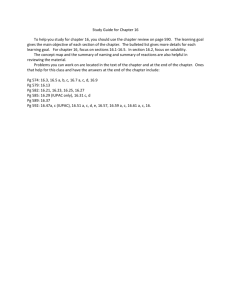
![Search for High-Mass e+e- Resonances in pp-bar Collisions at sqrt[s]=1.96 TeV](http://s2.studylib.net/store/data/012099594_1-3d3697a57081d795bb2905505b74eae7-300x300.png)
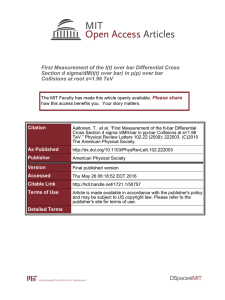
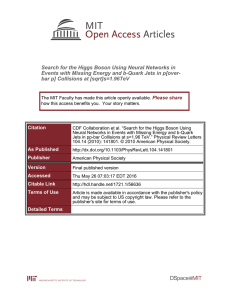
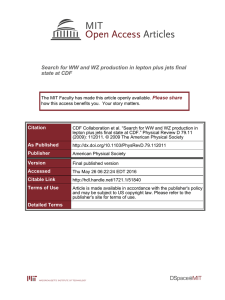
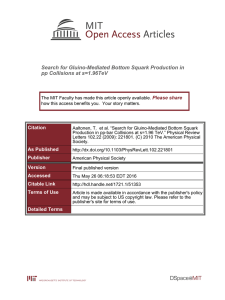

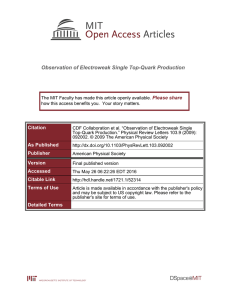
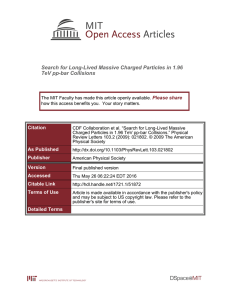
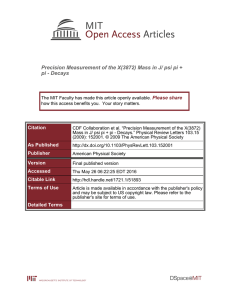
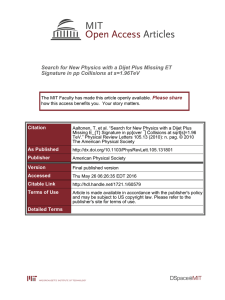
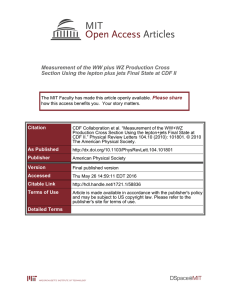
![Measurement of Z gamma production in pp[over-bar] collisions at [sqrt]s=1.96 TeV](http://s2.studylib.net/store/data/012381473_1-0a453f4a3b970be9736e3f07520faee0-300x300.png)
